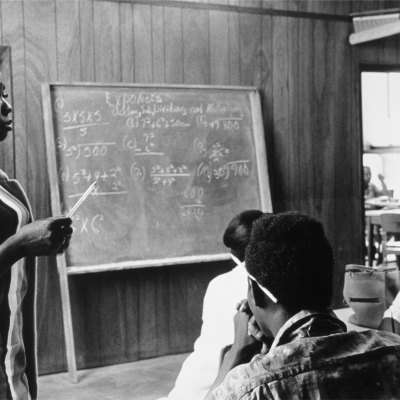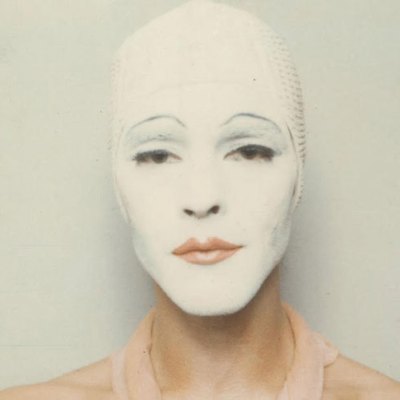Zanele Muholi is best known for their photographs of LGBT+ Black people in their homeland of South Africa, which range from intimate images of love and community to pictures of the aftermath of violence. Muholi describes themself as a visual activist rather than an artist. Self-portraits form a key strand of their practice, which they explore in the ongoing series Somnyama Ngonyama (‘Hail the Dark Lioness’). Works from this series are on show alongside photographs, films, paintings and sculptures dating from 2002 to the present in ‘Zanele Muholi: Eye Me’ at the San Francisco Museum of Modern Art (until 11 August).
Where is your studio?
The studio is any space where human beings are located. For Somnyama Ngonyama, it could be a hotel room, a playground, a kitchen, or a toilet – wherever. I don’t move around with heavy equipment that would determine where my studio is. The studio is the space and the time attached to the content that one is trying to produce. I wake up in the hotel room in San Francisco where I’ve been the last three days: that becomes my studio. People have a fixation on what a studio is; I just have my remotes, my camera, my tripod – or even just a pillow to keep the camera stable. It works. In terms of where community is at, if I’m shooting at Pride, say, then the studio becomes the streets of Joburg, the streets of Cape Town, the streets of Durban.
I think we need to break the conventions of what a studio is according to the definitions that we find in dictionaries or whatever. According to photographers, a studio is a formalised space. But then what if people do not have the luxury of having that beautiful studio? It goes back to the question of what exactly are we trying to achieve? The studio is any place where one can produce the content that needs to be shared with people.
Yaya Mavundla, Parktown, Johannesburg (2014), Zanele Muholi. Courtesy the artist and Yancey Richardson, New York; © Zanele Muholi

What is it like to work in this way?
What’s challenging is when we are documenting funerals, for instance. Does the church during a funeral become a studio? Would we say that a crime scene, where the body of a hate-crime victim has been discovered, becomes a studio? Do we say that the hospital bed of a person who has been brutalised becomes a studio? Or a police station? That becomes difficult for me, because then I have to look at the bloodiest spaces in which LGBT-identifying individuals have been undermined and call them ‘my studio’. But we do still count those spaces because they become part of the visual documentation of what happened when, where, why and how.
What’s the atmosphere like while you work?
If I’m shooting at a wedding and the music being played connects with the joys and jubilation of the ceremony, or if I’m shooting myself in a hotel room and playing gospel music in the background, that generally determines the final product. These things have to do with sound, which I try to be within at the time. If I work with different groups of people, the energy that we share among ourselves in a particular space also changes the context altogether.
Katlego Mashiloane and Nosipho Lavuta, Ext. 2, Lakeside, Johannesburg (2007), Zanele Muholi. Courtesy the artist and Yancey Richardson, New York; © Zanele Muholi

Do you ever play music while you work?
I have special songs. When I’m happy, I play them. Then there are also special songs that I listen to when I meditate without even being aware that I’m meditating. But it differs, I can’t say I’m always playing the same tunes. Do I eat and shoot? Hardly. But there’s water, there’s music, there’s those things that aren’t seen yet which form part of the production processes. I’d be lying if I said that under normal circumstances we shoot and play and all these beautiful images come from that joyous place, because most of the images are based on issues that make us feel otherwise – issues that make people look at images and cry, even though there’s no dead body, no one has passed, but because they move us somehow.
Thathu I, The Sails, Durban (2019), Zanele Muholi. © Zanele Muholi

What is your most well-thumbed book?
We don’t have many books that are done in a language that speaks to – that knows – me. There are books that make me want to produce content that speaks to the child me, you know, because I never had access to this as a child and I’m producing this for Black kids who might not have access to the photobooks that I longed for during the apartheid years. Sometimes there’ll be a book that from the outside speaks to me, and then inside I’ll find one picture that completely changes my way of looking at things, at people. But it’s never just one book.
I keep on revising my own book [Zanele Muholi: Somnyama Ngonyama, Hail the Dark Lioness (2018)] over and over, you know, what could I have done better? I also return to Sindiwe Magona, who has authored many books. One of her poems, ‘Please, Take Photographs’, became the name of her book that came out in 2009. It speaks about South Africa then, but it also speaks about South Africa now. Another one is Black Looks: Race and Representation (1992) by bell hooks. That book was my beginning, I think. But there are many others.
Cwazimula II, Paris, France (2019), Zanele Muholi. Courtesy Jonathan Carver Moore; © Zanele Muholi

‘Zanele Muholi: Eye Me’ is at the San Francisco Museum of Modern Art (SFMOMA) until 11 August.



